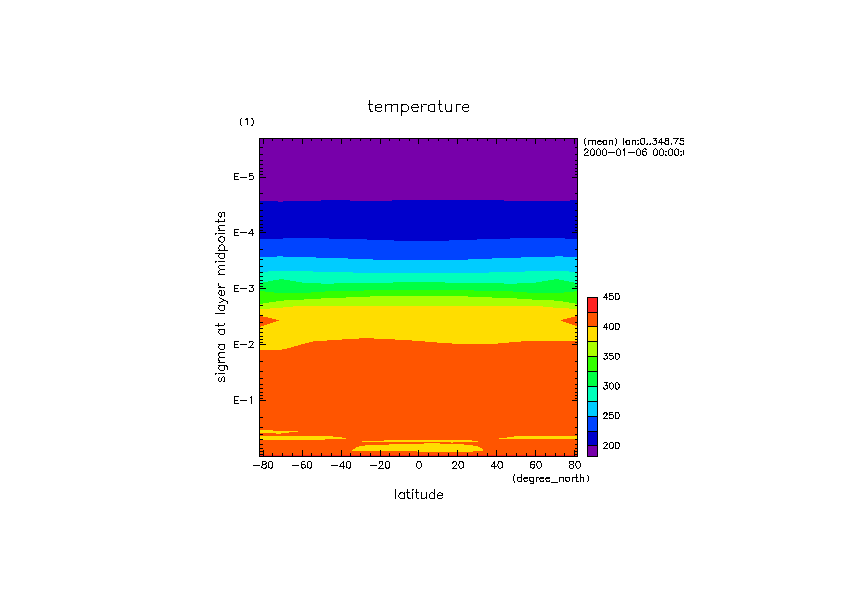
A method to perform an experiment for Venus-like planet by using forcing by Yamamoto and Takahashi (2003) is described.
This experiment does not require additional data, such as SST data. Thus, the experiment is performed with the following 3 steps:
Let us move to the top directory of dcpam5 src tree (assuming dcpam5-YYYYMMDD in the following example). Here, we perform an experiment in ../dcpam5-exp/Venuslike-exp directory. Please create the directory and enter there as follows:
$ mkdir -p ../dcpam5-exp/Venuslike-exp $ cd ../dcpam5-exp/Venuslike-exp
Then, pleaase create the directories for executable files and configuration files as follows:
$ mkdir bin $ mkdir conf
Finally, executable files and configuration files are copied as follows:
$ cp ../../dcpam5-YYYYMMDD/src/main/dcpam_main bin $ cp ../../dcpam5-YYYYMMDD/src/main/dcpam_init_data bin $ cp ../../dcpam5-YYYYMMDD/exp_setup_files/*.conf conf
Note that you can perform an experiment in any directory by using executable files and configuration (NAMELIST) files.
Create initial data file "init_T10L50.nc" using "dcpam_init_data" and "init_data_Vlp_T10L50.conf"
$ ./bin/dcpam_init_data -N=./conf/init_data_Vlp_T10L50.conf
*** MESSAGE [init_data] *** Run: Initial data generation
*** MESSAGE [init_data] *** -- version = $Name: dcpam5-20131007 $$Id: exp-Venuslike.rd,v 1.10 2013-10-06 13:46:12 yot Exp $
*** MESSAGE [namelist_util] *** ----- Initialization Messages -----
*** MESSAGE [namelist_util] *** MaxNmlArySize = 256
*** MESSAGE [namelist_util] *** -- version = $Name: dcpam5-20131007 $$Id: exp-Venuslike.rd,v 1.10 2013-10-06 13:46:12 yot Exp $
*** WARNING [timeset] *** NAMELIST group "timeset_nml" is not found in "./conf/init_data_Vlp_T10L50.conf" (iostat=186).
*** MESSAGE [timeset] *** ----- Initialization Messages -----
:
*** MESSAGE [initial_data] *** ----- Initialization Messages -----
*** MESSAGE [initial_data] *** Pattern = SmallVapAvr = 0.
*** MESSAGE [initial_data] *** Ueq = 0.
*** MESSAGE [initial_data] ***
*** MESSAGE [initial_data] *** -- version = $Name: dcpam5-20131007 $$Id: exp-Venuslike.rd,v 1.10 2013-10-06 13:46:12 yot Exp $
Using an executable files 'dcpam_main' and a NAMELIST file dcpam_Vlp_T10L50.conf, execute 'dcpam_main' as follows. This program will be finished in few minutes - tens of minutes.
$ ./bin/dcpam_main -N=./conf/dcpam_Vlp_T10L50.conf | tee Vlp.log
*** MESSAGE [namelist_util] *** ----- Initialization Messages -----
*** MESSAGE [namelist_util] *** MaxNmlArySize = 256
*** MESSAGE [namelist_util] *** -- version = $Name: dcpam5-20131007 $$Id: exp-Venuslike.rd,v 1.10 2013-10-06 13:46:12 yot Exp $
*** MESSAGE [dcpam_main] *** NAMELIST group "dcpam_main_nml" is loaded from "./conf/dcpam_Vlp_T10L50.conf".
&DCPAM_MAIN_NML FLAGDYNAMICS=T,FLAGFULLPHYSICS=F,FLAGHS94=F,FLAGVENUSSIMPLE=T,FLAGJUPITERSIMPLE=F,FLAGRADIATIONDENNOUAGCM=T,FLAGRADIATIONDCPAMEV1=F,FLAGRADIATIONDCPAMMV1=F,FLAGRADIATIONSL09=F,FLAGPHYIMP1LAYMODEL=T,FLAGPHYIMPSOILMODEL=F,FLAGPHYIMPSOILMODELSO=F,FLAGPHYIMPATMONLY=F,FLAGVERTICALFILTER=F/
*** MESSAGE [dcpam_main] *** FlagDynamics=<T>.
*** MESSAGE [dcpam_main] *** FlagRadiationDennouAGCM=<T>.
*** MESSAGE [dcpam_main] *** FlagRadiationDcpamEV1 =<F>.
*** MESSAGE [dcpam_main] *** FlagRadiationDcpamMV1 =<F>.
:
*** MESSAGE [HistoryClose] *** "VUBalance.nc" is closed
############## CPU TIME SUMMARY ################
surface_properties 0.000000E+00
auxiliary 0.108007E+00
vdiffusion_my1974 0.520025E-01
dynamics_hspl_vas83 0.187212E+01
mass_fixer 0.280015E-01
check_prog_vars 0.800041E-02
timefilter_asselin19 0.280015E-01
others 0.552037E+00
------------------------------------------------
TOTAL TIME = 0.264816E+01
In this case, 5 days integration is performed. Resolution is T10L50 (Number of grid points of longitude, latitude is 32, 16, and number of vertical layer is 50). History data are output to 'U.nc' and 'Temp.nc' etc., and a restart data is output to 'restart.nc'.
Zonal mean temperature distribution after integration for 5 days is shown below.

This figure is drawn by using Gphys, as follows:
Please type irb.
$ irb
Following prompt of irb is shown.
irb(main):001:0>
Type following lines. Please note that the left-most number is line number, and it has not been typed.
1: require "numru/ggraph"
2: include NumRu
3: gphys = GPhys::IO.open('Temp.nc', 'Temp')
4: DCL.gropn(1)
5: DCL.sgpset('lcntl', false) ; DCL.uzfact(0.7)
6: GGraph.set_fig( 'itr'=> 2 )
7: GGraph.tone( gphys.mean('lon').cut('time'=>5) )
8: GGraph.color_bar
9: DCL.grcls
Type quit to exit irb.
Above figure shows spin-up phase of the atmosphere, because Venus' atmosphere does not reach quasi-equilibrium in 5 days.
If you would like to keep the results of the numerical experiment, please create a sub directory ("data01" for example), move the files, and keep the current directory neatly.
$ mkdir data01 $ mv *.nc *.log data01/
You can output the results of the numerical experimet concurrently with the execution. Please refer to "Change output settings" in Change experimental setup and try to configure "FilePrefix" variable in NAMELIST ">ool_historyauto_nml".
